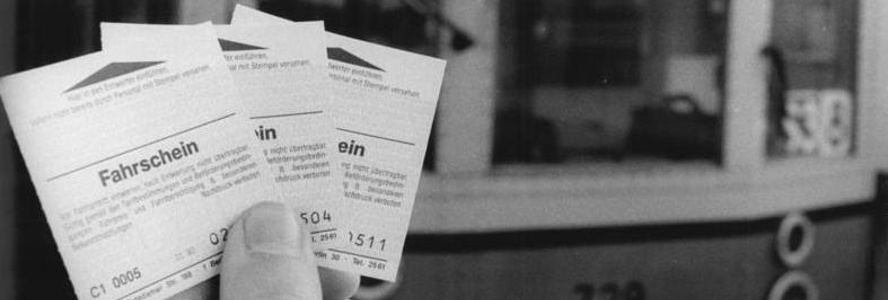You need a fahrschein to use the nakadi event bus.
Image Source: Deutsches Bundesarchiv, Photographer: Ralph Hirschberger, Image License: CC BY-SA 3.0 DE
- Consistent error handling
- Stream-based parsing
- Optimized utf-8 decoding by Jackson
- No unnecessary buffering or line-based processing, causing less garbage
- Less garbage and higher performance
- No required base classes for events
- Support for both high-level (subscription) and low-level apis
- Pluggable HTTP client implementations
Fahrschein is available in maven central, so you only have to add the following dependency to your project:
<dependency>
<groupId>org.zalando</groupId>
<artifactId>fahrschein</artifactId>
<version>${fahrschein.version}</version>
</dependency>final String eventName = "sales-order-placed";
// Create a Listener for our event
final Listener<SalesOrderPlaced> listener = events -> {
for (SalesOrderPlaced salesOrderPlaced : events) {
LOG.info("Received sales order [{}]", salesOrderPlaced.getSalesOrder().getOrderNumber());
}
};
// Configure client, defaults to using the high level api with ManagedCursorManger and SimpleRequestFactory
final NakadiClient nakadiClient = NakadiClient.builder(NAKADI_URI)
.withAccessTokenProvider(new ZignAccessTokenProvider())
.build();
// Create subscription using the high level api
Subscription subscription = nakadiClient.subscription(applicationName, eventName).subscribe();
// Start streaming, the listen call will block and automatically reconnect on IOException
nakadiClient.stream(subscription)
.listen(SalesOrderPlaced.class, listener);See Main.java for an executable version of the above code.
By default nakadi will start streaming from the most recent offset. The initial offsets can be changed by requesting data about partitions from Nakadi and using this data to configure CursorManager.
final List<Partition> partitions = nakadiClient.getPartitions(eventName);
// The cursor manager can be configured to start reading from the oldest available offset in each partition
cursorManager.fromOldestAvailableOffset(eventName, partitions);
// Or from the newest available offset, but this is the same as the default
cursorManager.fromNewestAvailableOffsets(eventName, partitions);
// Or (for a persistent cursor manager) we can start reading from the last offset that we processed if it's still available, and from the oldest available offset otherwise
cursorManager.updatePartitions(eventName, partitions);You can also use the low-level api, which requires local persistence of partition offsets. There are persistent CursorManager implementations using either Postgres or Redis.
final HikariConfig hikariConfig = new HikariConfig();
hikariConfig.setJdbcUrl("jdbc:postgresql://localhost:5432/local_nakadi_cursor_db");
hikariConfig.setUsername("postgres");
hikariConfig.setPassword("postgres");
final DataSource dataSource = new HikariDataSource(hikariConfig);
final CursorManager cursorManager = new JdbcCursorManager(dataSource, "fahrschein-demo");
final NakadiClient nakadiClient = NakadiClient.builder(NAKADI_URI)
.withAccessTokenProvider(new ZignAccessTokenProvider())
.withCursorManager(cursorManager)
.build();
nakadiClient.stream(eventName)
.listen(SalesOrderPlaced.class, listener);With the PartitionManager api it is possible to coordinate between multiple nodes of one application, so that only one node is consuming events from a partition at the same time.
Partitions are locked by one node for a certain time. This requires that every node has an unique name or other identifier.
@Scheduled(fixedDelay = 60*1000L)
public void readSalesOrderPlacedEvents() throws IOException {
final String lockedBy = ... // host name or another unique identifier for this node
final List<Partition> partitions = nakadiClient.getPartitions(eventName);
final Optional<Lock> optionalLock = partitionManager.lockPartitions(eventName, partitions, lockedBy);
if (optionalLock.isPresent()) {
final Lock lock = optionalLock.get();
try {
nakadiClient.stream(eventName)
.withLock(lock))
.listen(SalesOrderPlaced.class, listener);
} finally {
partitionManager.unlockPartitions(lock);
}
}
}Exception handling while streaming events follows some simple rules
IOExceptionand its subclasses are treated as temporary failures. Library will automatically recover from this type of failure by retrying processing attempt after time interval specified by theBackoffStrategy. Special case: if anIOExceptionhappens during opening the initial connection, this is treated as configuration problem (wrong host name or missing scopes). In this case processing will be aborted and exception will be re-thrown.- If
listenerthrowsRuntimeExceptionstreaming of events will be aborted. User is responsible for handling these exceptions. Library code itself will not throwRuntimeExceptions. - Exceptions in other client methods are not automatically retried
The stream implementation gracefully handles thread interruption, so it is possible to stop a running thread and resume consuming events by re-submitting the Runnable:
final ExecutorService executorService = Executors.newSingleThreadExecutor();
final Runnable runnable = nakadiClient.stream(SALES_ORDER_SERVICE_ORDER_PLACED)
.runnable(SalesOrderPlaced.class, listener)
.unchecked();
// start consuming events
final Future<?> future = executorService.submit(runnable);
// stop consuming events
future.cancel(true);
// resume consuming events
final Future<?> future2 = executorService.submit(runnable);You might want to ignore events that could not be mapped to your domain objects by Jackson, instead of having these events block all further processing.
To achieve this you can implement the onMappingException method of the ErrorHandler interface handle the JsonMappingException yourself.
nakadiClient.stream(eventName)
.withErrorHandler(e -> {...})
.listen(SalesOrderPlaced.class, listener);Fahrschein uses it's own http abstraction which is very similar to spring framework's ClientHttpRequestFactory interface. By default it uses the SimpleRequestFactory which uses a HttpURLConnection internally and has no further dependencies.
There is also a version using apache http components named HttpComponentsRequestFactory in the fahrschein-http-apache artifact.
<dependency>
<groupId>org.zalando</groupId>
<artifactId>fahrschein-http-apache</artifactId>
<version>${fahrschein.version}</version>
</dependency>The apache version is useful when you want more control about the number of parallel connections in total or per host. The following example shows how to use a customized HttpClient:
final RequestConfig config = RequestConfig.custom().setSocketTimeout(readTimeout)
.setConnectTimeout(connectTimeout)
.setConnectionRequestTimeout(connectTimeout)
.build();
final CloseableHttpClient httpClient = HttpClients.custom()
.setConnectionTimeToLive(readTimeout, TimeUnit.MILLISECONDS)
.disableAutomaticRetries()
.setDefaultRequestConfig(config)
.disableRedirectHandling()
.setMaxConnTotal(8)
.setMaxConnPerRoute(2)
.build();
final RequestFactory requestFactory = new HttpComponentsRequestFactory(httpClient);
final NakadiClient nakadiClient = NakadiClient.builder(NAKADI_URI)
.withRequestFactory(requestFactory)
.withAccessTokenProvider(new ZignAccessTokenProvider())
.build();It is also possible to adapt other implementations from spring framework by wrapping them into SpringRequestFactory, contained in the fahrschein-http-spring artifact.
<dependency>
<groupId>org.zalando</groupId>
<artifactId>fahrschein-http-spring</artifactId>
<version>${fahrschein.version}</version>
</dependency>Example using OkHttp 3.x:
final ClientHttpRequestFactory clientHttpRequestFactory = new OkHttp3ClientHttpRequestFactory();
final RequestFactory requestFactory = new SpringRequestFactory(clientHttpRequestFactory);
final NakadiClient nakadiClient = NakadiClient.builder(NAKADI_URI)
.withRequestFactory(requestFactory)
.withAccessTokenProvider(new ZignAccessTokenProvider())
.build();Note: The implementations from spring framework don't handle closing of streams as expected. They will try to consume remaining data, which will usually time out when nakadi does not receive a commit.
| Fahrschein | Nakadi-Klients | Reactive-Nakadi | Straw | |
|---|---|---|---|---|
| Dependencies | Jackson | Scala, Akka, Jackson | Scala, Akka | None |
| Cursor Management | In-Memory / Persistent (Postgres or Redis) | In-Memory | Persistent (Dynamo) | |
| Partition Management | In-Memory / Persistent (Postgres) | Persistent (Dynamo) (?) | ||
| Error Handling | Automatic reconnect with exponential backoff | Automatic reconnect | (?) | No error handling |
If you have questions, concerns, bug reports, etc, please file an issue in this repository's issue tracker.
To contribute, simply make a pull request and add a brief description (1-2 sentences) of your addition or change. For more details check the contribution guidelines.


